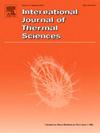Development of a renewable technology for air heating and thermal cooling of sub-arctic mines using spray freezing
IF 4.9
2区 工程技术
Q1 ENGINEERING, MECHANICAL
International Journal of Thermal Sciences
Pub Date : 2025-01-24
DOI:10.1016/j.ijthermalsci.2025.109704
引用次数: 0
Abstract
Mining industry is associated with high energy consumption and greenhouse gas (GHG) emissions due to intensive extraction processes and reliance on fossil fuel, specifically propane and diesel. In remote mines located in sub-arctic climates, heating and cooling operations can take up to half of this energy consumption, highlighting the importance of exploring innovative clean alternatives. The present study investigates one emerging solution to address this energy demand, known as spray freezing, in which the solidification of water droplets is used to provide the heating and cooling needs of mines. A multiscale thermo-hydraulic framework for spray freezing is developed, coupling the multi-stage droplet solidification process with a reduced-order spray-droplet dynamics model. Parametric studies are conducted using the Monte-Carlo method to quantify the effects of operating parameters on the system performance. It is found that the heat rate and cooling capacity of the spray freezing system are predominantly influenced by water flow rate and air temperature. Increasing the water flow rate from 7.5 kg/s to 30 kg/s can increase the heat rate to up to 400%. The ice generation of the system depends most on the air temperature, increasing significantly when the temperature drops below the water nucleation point, approximately -14 °C. Eventually, a multi-variate regression method is used to derive three user-friendly correlations that predict the heat rate, outlet air temperature, and ice generation of the spray freezing system, allowing a quick evaluation of the system performance in on-site applications.
求助全文
约1分钟内获得全文
求助全文
来源期刊

International Journal of Thermal Sciences
工程技术-工程:机械
CiteScore
8.10
自引率
11.10%
发文量
531
审稿时长
55 days
期刊介绍:
The International Journal of Thermal Sciences is a journal devoted to the publication of fundamental studies on the physics of transfer processes in general, with an emphasis on thermal aspects and also applied research on various processes, energy systems and the environment. Articles are published in English and French, and are subject to peer review.
The fundamental subjects considered within the scope of the journal are:
* Heat and relevant mass transfer at all scales (nano, micro and macro) and in all types of material (heterogeneous, composites, biological,...) and fluid flow
* Forced, natural or mixed convection in reactive or non-reactive media
* Single or multi–phase fluid flow with or without phase change
* Near–and far–field radiative heat transfer
* Combined modes of heat transfer in complex systems (for example, plasmas, biological, geological,...)
* Multiscale modelling
The applied research topics include:
* Heat exchangers, heat pipes, cooling processes
* Transport phenomena taking place in industrial processes (chemical, food and agricultural, metallurgical, space and aeronautical, automobile industries)
* Nano–and micro–technology for energy, space, biosystems and devices
* Heat transport analysis in advanced systems
* Impact of energy–related processes on environment, and emerging energy systems
The study of thermophysical properties of materials and fluids, thermal measurement techniques, inverse methods, and the developments of experimental methods are within the scope of the International Journal of Thermal Sciences which also covers the modelling, and numerical methods applied to thermal transfer.
 求助内容:
求助内容: 应助结果提醒方式:
应助结果提醒方式:


